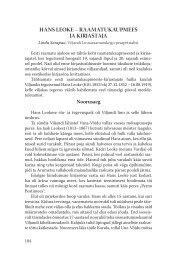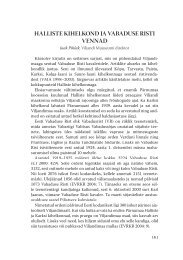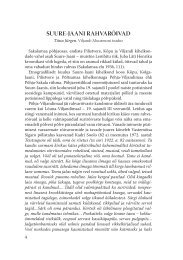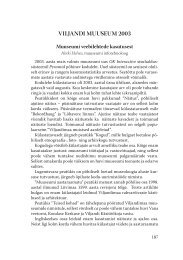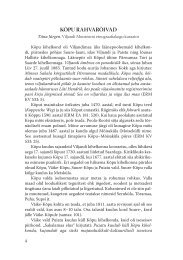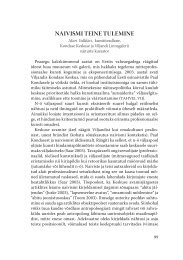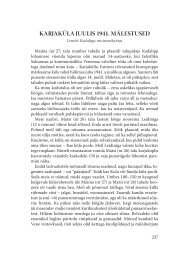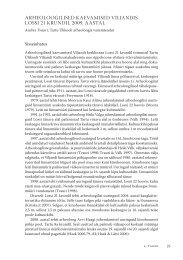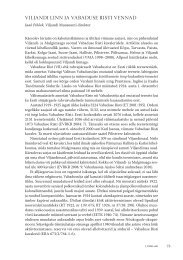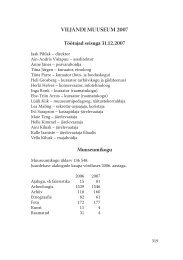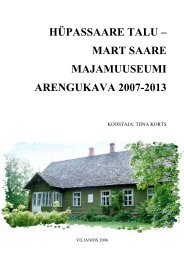uusi andmeid viljandi suusahüppemäelt: 1223 ... - Viljandi Muuseum
uusi andmeid viljandi suusahüppemäelt: 1223 ... - Viljandi Muuseum
uusi andmeid viljandi suusahüppemäelt: 1223 ... - Viljandi Muuseum
You also want an ePaper? Increase the reach of your titles
YUMPU automatically turns print PDFs into web optimized ePapers that Google loves.
Uusi <strong>andmeid</strong> <strong>Viljandi</strong> Suusahüppemäelt: <strong>1223</strong>. a piiramisrajatistest...<br />
Kirjandus<br />
Rammo, R. & Veldi, M. 2005. 2004. aasta kaevamised <strong>Viljandi</strong> Musumäel.<br />
– <strong>Viljandi</strong> <strong>Muuseum</strong>i aastaraamat 2004. <strong>Viljandi</strong>, 97–111.<br />
Valk H. 2000a. Archaeological Investigations in Late Prehistoric – Early<br />
Medieval <strong>Viljandi</strong> and in Pilistvere Churchyard. – Arheoloogilised välitööd<br />
Eestis / Archaeological Field Works in Estonia 1999, 39–53.<br />
Valk H. 2000b. Muinas-<strong>Viljandi</strong> Lossimägede taga. – <strong>Viljandi</strong> <strong>Muuseum</strong>i<br />
aastaraamat 1999. <strong>Viljandi</strong>, 56–78.<br />
Valk, H. 2003a. Uut hilismuinasaegsest ülikumajapidamisest <strong>Viljandi</strong><br />
Suusahüppemäel ja <strong>1223</strong>. aasta augustipiiramisest. – <strong>Viljandi</strong> <strong>Muuseum</strong>i<br />
aastaraamat 2002. <strong>Viljandi</strong>, 56–70.<br />
Valk, H. 2003b. Excavations in <strong>Viljandi</strong>: new data about the final period<br />
of Iron Age and the besieging of <strong>1223</strong>. – Arheoloogilised välitööd Eestis /<br />
Archaeological Fieldwork in Estonia 2002. Tallinn, 56–70.<br />
66<br />
NEW DATA FROM THE SKI-JUMPING HILL OF VILJANDI:<br />
ABOUT THE BESIEGING CONSTRUCTIONS FROM <strong>1223</strong><br />
AND THE ORIGINAL SHAPE OF THE HILL<br />
Heiki Valk<br />
In 2005 excavations were continued on the Ski-jumping hill of <strong>Viljandi</strong><br />
where remains of besieging constructions from <strong>1223</strong> and of timber houses,<br />
burnt at that time, had been studied in 1999 and 2002. Most of the excavation<br />
plot (20 m 2 ) happened to be on the original slope of the hill, the plateau<br />
of which had been broadened for 3 metres during the besieging of <strong>1223</strong>. The<br />
layer of soil, heaped up on the hill to form a basis for the besieging machines<br />
(or their platforms) was 50–60 cm thick. It originated from the periphery of a<br />
Late Iron Age settlement site and was quite poor in finds, containing mostly<br />
pottery.<br />
The fill layer contained two irregular clusters of stones (diameters at least<br />
2–3 m and 1–2 m). The aim of these stone clusters was probably to strengthen<br />
the basis of the trebuchets. In the intact natural ground 10 post-holes<br />
(diameter 40–70 cm and depth 40–80 cm) were revealed. The holes which<br />
were located on the initial plateau of the hill were, judging by their fill, not<br />
related to the Late Iron Age settlement traces but to the besieging activities of<br />
<strong>1223</strong>. The Late Iron Age cultural layer on the hill-slope of that time was very




